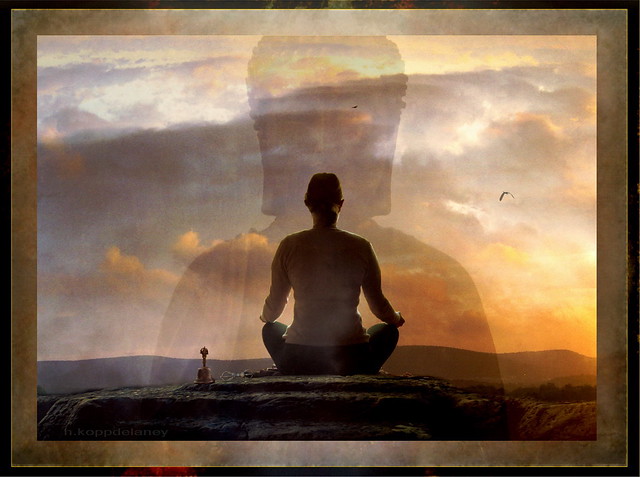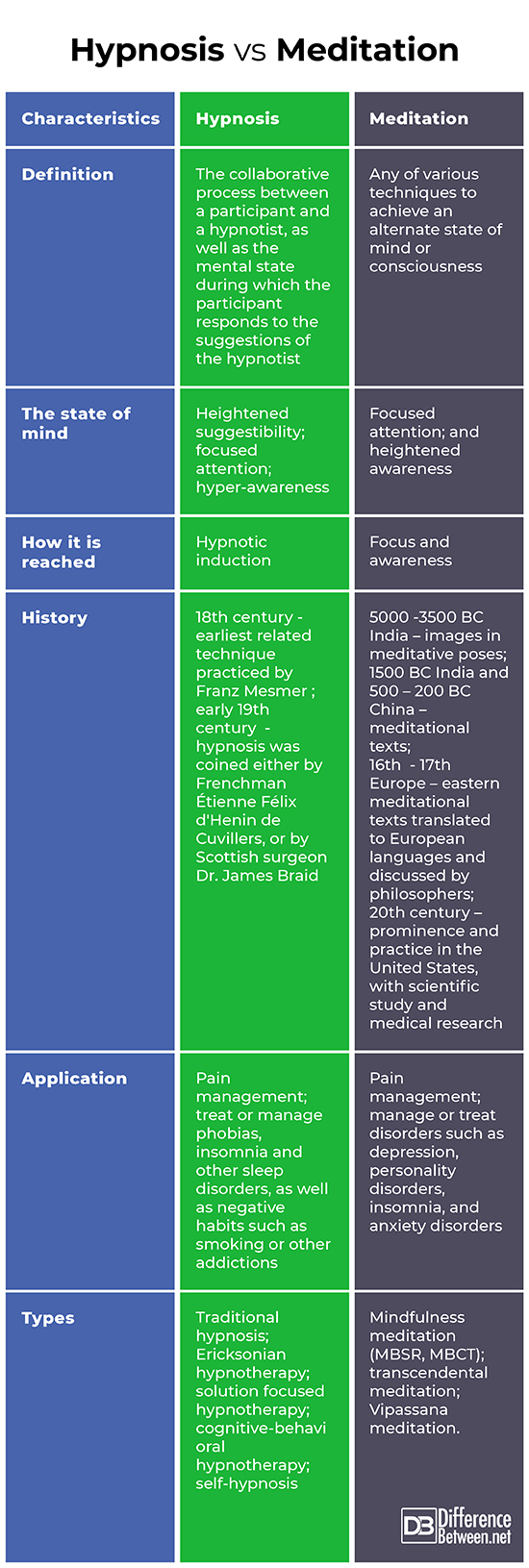Difference Between Hypnosis and Meditation
Hypnosis and meditation: mental techniques and practices with no single definition but have something to do with reaching altered state of mind which would eventually result in good health and wellbeing. Despite their long histories, there is still an air of skepticism towards these two concepts. Perhaps it is those demonstrations of individuals clucking like chickens to the suggestions of a hypnotist. As for meditation, even discounting its spiritual and religious backgrounds, the often vague and sometimes incoherent terminologies certainly make it prone to accusations of mysticism. In any case, in the world of alternative medicine and healthy living, the popularity of both hypnosis and meditation is indisputable, and each one seems to work for their respective adherents who tout their benefits.
The main difference between hypnosis and meditation seems obvious at first. Hypnosis is induced by a hypnotist while meditation is engaged individually. To be more precise though, the two also differ in the kind mental state that the individual is under. There are also some differences in the kind of health benefits that can be gained with the practice of each one. Hypnosis and meditation, as well as their differences, are explored further in the following sections.

What is Hypnosis?
Hypnosis is both the collaborative process between a participant and a hypnotist, and the mental state during which the participant responds to the suggestions of the hypnotist. The common description of outside observers of hypnosis being a sleep-like or trance-like state is not quite correct, although understandable since hypnosis is derived from the Greek word hypnos which means ‘sleep’. The hallmark of the state of hypnosis is heightened suggestibility, but practitioners also describe focused attention and hyper-awareness. This mental state is induced by the hypnotist onto the participant by various means, although most techniques of hypnotic induction require relaxation and repetition, somewhat akin to the pop-culture image of swinging a watch in front of the participant and having the participant follow the watch’s movement.
The earliest relatable form is the technique used by 18th century German doctor, Franz Mesmer who attempted to demonstrate his theory of energy transfer between animate and inanimate objects which can be controlled to influence people’s behavior. The term itself is believed to be coined in the early 19th century either by Frenchman Étienne Félix d’Henin de Cuvillers, or by Scottish surgeon Dr. James Braid.
Hypnosis is most commonly used to manage pain in medical conditions such as arthritis or irritable bowel syndrome (IBS), as in dental procedures or childbirth. It is also common in psychiatric and psychological work to treat or manage phobias, insomnia and other sleep disorders, as well as negative habits such as smoking or other addictions. Several types of hypnosis, called hypnotherapy, have been developed over the years. Some well-known techniques are the traditional type which was practiced by Victorian era hypnotists, Ericksonian which was founded by the psychiatrist Milton Erickson who is also known as the father of modern hypnotherapy, solution focused hypnotherapy which focuses on the solution to the problem rather than the problem itself and involves setting future goals for oneself, and cognitive-behavioral which aims to help connect and align conscious and subconscious. Self-hypnosis is a technique often advertised to achieve relaxation and self-confidence, a process which is very similar to meditation.

What is Meditation?
Mediation is any of various techniques to achieve an alternate state of mind or consciousness. Historically, meditation is done in various religious traditions to either connect with a higher being or to reach a higher state of being. Modern practices of meditation are based on these ancient practices but are devoid of the spiritual dimension, becoming instead both the technique and the goal, which is focused attention or heightened awareness. There are two main methods used by practitioners to reach that higher state of consciousness or being. The first is by focusing on a specific object such as a candle, one’s own breath or breathing, an image, a word or a mantra. The second method is by being aware of oneself in the moment, as well as one’s surroundings including what is happening all around.
Meditation dates back to ancient history, with images of meditative poses dating as far back as 5000 – 3500 BC and texts dating back to 1500 BC in India. China also has its own share, with texts dating back to 500 – 200 BC. The older religions such as Hinduism, Buddhism and Taoism are most prominent sources of meditative practice although relatively newer ones like Islam, Judaism and Christianity have their own traditions. With the translation of Eastern texts, 16th and 17th century European philosophers like Voltaire and Schopenhauer took up meditation as a topic for discussion. Only in the 20th century did meditation come into prominence and practice in the United States, accompanied by scientific study and research on medical application.
Aside from self-practice, meditation is sometimes recommended by medical practitioners as an alternative to pain management. Mental health professionals also use meditation programs to manage or treat disorders such as depression, personality disorders, insomnia, and anxiety disorders. Among the many meditational types and techniques used today are mindfulness meditation, which includes Mindfulness-Based Stress Reduction (MBSR) and Mindfulness-Based Cognitive Therapy (MBCT), transcendental meditation which is a specific meditative practice involving repetition of a sound called a mantra and seeks to help a practitioner reach a state of relaxed awareness, and Vipassana meditation, one of the oldest Buddhist in which the individual is encouraged to seek true understanding into the nature of their own reality.
Difference between Hypnosis and Meditation
Definition
Hypnosis is the collaborative process between a participant and a hypnotist, as well as the mental state during which the participant responds to the suggestions of the hypnotist. Mediation is any of various techniques to achieve an alternate state of mind or consciousness.
The state of mind
In hypnosis, the participant is induced into a state of heightened suggestibility, focused attention and hyper-awareness. During meditation, a practitioner reaches a state of higher consciousness with focused attention and heightened awareness.
How it is reached
Hypnosis is achieved through various methods, collectively called hypnotic induction. Meditative states are reached by focusing on a specific object or image, or by being aware of oneself, in the moment, and one’s surroundings.
History
The earliest related technique to hypnosis was practiced by Franz Mesmer during the 18th century. The word hypnosis itself was coined in the early 19th century either by Frenchman Étienne Félix d’Henin de Cuvillers, or by Scottish surgeon Dr. James Braid. Images of meditative poses can be traced back to 5000 -3500 BC India, while meditative texts date back to 1500 BC India and 500 – 200 BC China. Meditational texts were translated to European languages and discussed by philosophers during the 16th and 17th centuries, but only came to prominence and practice during the 20th century, accompanied by scientific study and medical research.
Application
Hypnosis is most common used to manage pain in medical conditions and procedures as well as treat or manage phobias, insomnia and other sleep disorders, as well as negative habits such as smoking or other addictions. Meditation techniques are also used as an alternative to pain management, and meditation programs are used to manage or treat disorders such as depression, personality disorders, insomnia, and anxiety disorders
Types
Some of the types of hypnosis are traditional hypnosis, Ericksonian hypnotherapy, solution focused hypnotherapy, cognitive-behavioral hypnotherapy, and self-hypnosis. Among the many types of meditational techniques are mindfulness meditation (MBSR, MBCT), transcendental meditation, and Vipassana meditation.
Hypnosis vs Meditation

Summary
- Hypnosis and meditation are practices or techniques used to induce or reach an altered state of mind or consciousness with the purpose of achieving positive health benefits.
- Hypnosis is a collaborative interaction between the participant and the hypnotist during which the participant is induced into a state of heightened suggestibility, focused attention and hyper-awareness.
- Meditation is any of various practices to achieve an alternate state of mind or consciousness, wherein the practitioner uses focus and awareness techniques to reach a higher state of being.
- Despite popularity and touted benefits, there remains skepticism towards these two practices, mainly because of limited understanding, sensational demonstrations, and vague or mystical terminologies.
- Difference Between Hematoma and Melanoma - February 9, 2023
- Difference Between Bruising and Necrosis - February 8, 2023
- Difference Between Brain Hematoma and Brain Hemorrhage - February 8, 2023
Search DifferenceBetween.net :
Leave a Response
References :
[0]Image credit: https://live.staticflickr.com/3297/3522744145_023eca1280_z.jpg
[1]Image credit: https://storage.needpix.com/rsynced_images/hypnosis-4041583_1280.jpg
[2]Bohren, Anna. "Hypnotherapy: What is it, what are the different types and treatments?" CogniFit. January 29, 2018. https://blog.cognifit.com/hypnotherapy/ (accessed February 13, 2020).
[3]Cherry, Kendra. "How Hypnosis Is Used in Psychology." VeryWellMind. January 6, 2020. https://www.verywellmind.com/what-is-hypnosis-2795921#myths (accessed February 13, 2020).
[4]Cohut, Maria. "Hypnosis: What is it, and does it work?" MedicalNewsToday. September 1, 2017. https://www.medicalnewstoday.com/articles/319251#1 (accessed February 13, 2020).
